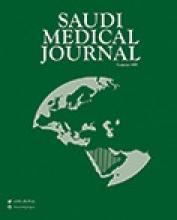Abstract
OBJECTIVE: Diabetes mellitus (DM) is a major public health problem worldwide, and it is a known risk factor for coronary artery disease (CAD). New recommendations for the diagnosis of diabetes have changed the epidemiology of DM. Therefore, we designed this study with the objective to determine the prevalence of DM among Saudis of both sexes, between the ages of 30-70-years in rural as well as urban communities. This work is part of a major national project: Coronary Artery Disease in Saudis study (CADISS) that is designed to look at CAD and its risk factors in Saudi population.
METHODS: This study is a community-based national epidemiological health survey, conducted by examining Saudi subjects in the age group of 30-70-years of selected households over a 5-year period between 1995 and 2000. Data were obtained from history, fasting plasma glucose levels, and body mass index. The data were analyzed to classify individuals as diabetic, impaired fasting glucose and normal, using 1997 American Diabetes Association (ADA) criteria, which was adopted by the World Health Organization (WHO) in 1998, to provide prevalence of DM in the Kingdom of Saudi Arabia (KSA).
RESULTS: A total of 17232 Saudi subjects were selected in the study, and 16917 participated (98.2% response rate). Four thousand and four subjects (23.7%), out of 16917 were diagnosed to have DM. Thus, the overall prevalence of DM obtained from this study is 23.7% in KSA. The prevalence in males and females were 26.2% and 21.5% (p<0.00001). The calculated age-adjusted prevalence for Saudi population for the year 2000 is 21.9%. Diabetes mellitus was more prevalent among Saudis living in urban areas of 25.5% compared to rural Saudis of 19.5% (p<0.00001). Despite the readily available access to healthcare facilities in KSA, a large number of diabetics 1116 (27.9%) were unaware of having DM.
CONCLUSION: The overall prevalence of DM in adults in KSA is 23.7%. A national prevention program at community level targeting high risk groups should be implemented sooner to prevent DM. We further recommend a longitudinal study to demonstrate the importance of modifying risk factors for the development of DM and reducing its prevalence in KSA.
- Copyright: © Saudi Medical Journal
This is an open-access article distributed under the terms of the Creative Commons Attribution-Noncommercial-Share Alike 3.0 Unported, which permits unrestricted use, distribution, and reproduction in any medium, provided the original work is properly cited.






